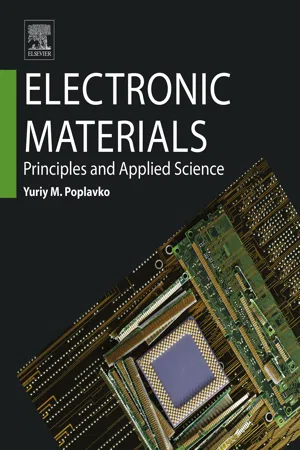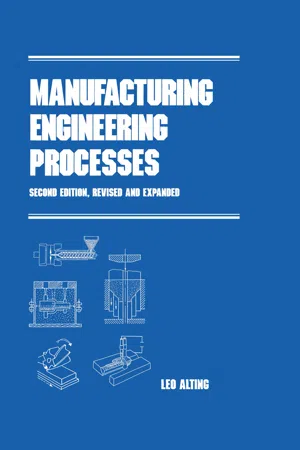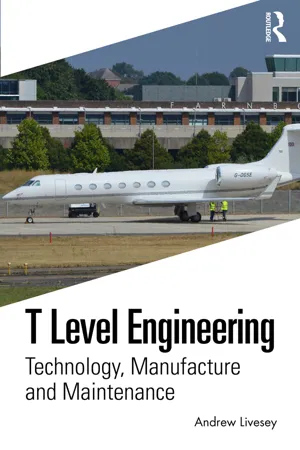Technology & Engineering
Metals
Metals are a category of chemical elements known for their luster, conductivity, and malleability. They are widely used in various technological and engineering applications due to their strength and durability. Common metals include iron, aluminum, copper, and gold, and they play a crucial role in the development of machinery, infrastructure, and electronic devices.
Written by Perlego with AI-assistance
Related key terms
Related key terms
1 of 4
Related key terms
1 of 3
5 Key excerpts on "Metals"
- eBook - ePub
Applied Welding Engineering
Processes, Codes, and Standards
- Ramesh Singh(Author)
- 2020(Publication Date)
- Butterworth-Heinemann(Publisher)
Section 1 Introduction to Basic MetallurgyPassage contains an image
1Introduction
Abstract
This chapter is an introduction to metallurgy, with definitions and explanations of a few very commonly used terms related to material extraction and processing.Keywords
Process metallurgy; Physical metallurgy; Mechanical metallurgy; Iron; SmeltingWhen we talk of metallurgy as a science of the study of Metals, the first question that arises in the mind is “What is a metal?” Most of us can recall the introductory study of Metals in basic physics in school.Metals are best described by their properties. Metals are crystalline in the solid state. Except for mercury, Metals are solid at room temperature; mercury is a metal but in liquid form at room temperature. Metals are good conductors of heat and electricity, and they usually have comparatively high density. Most Metals are ductile, a property that allows them to be shaped and changed permanently without breaking by the application of relatively high forces. Metals are elements, and metal are also alloys created by man in pursuit of specific properties. Aluminum, iron, copper, gold, and silver are examples of Metals as elements, and brass, steel, bronze, etc. are examples of alloys, the man-made Metals.Metallurgy is the science and technology of Metals and alloys. The study of metallurgy can be divided into three general groups:- 1. Process metallurgy Process metallurgy is concerned with the extraction of Metals from their ores and the refining of Metals. A brief discussion on production of steel, castings, and aluminum is included in this section.
- 2. Physical metallurgy Physical metallurgy is concerned with the physical and mechanical properties of Metals affected by composition processing and environmental conditions. A number of chapters in this section specifically address this topic.
- 3. Mechanical metallurgy Mechanical metallurgy is concerned with the response of Metals to applied forces. This is addressed in subsequent chapters of this section.
- eBook - ePub
Electronic Materials
Principles and Applied Science
- Yuriy M. Poplavko(Author)
- 2018(Publication Date)
- Elsevier(Publisher)
liquid conductors are also of technical interest: they are various electrolytes and molten Metals. However, for most Metals, rather high melting point is peculiar; only mercury and some special alloys (e.g., indium-gallium alloy) can be applied as liquid conductors at conventional temperatures.The mechanism of current flowing in Metals—as in both solid and liquid phases—is due to the movement of electrons; therefore, they are called as conductors with electronic conductivity .5.1 Defining Features of Metals
The term “metal” originated from the Greek word “metallon,” which means “mine.” Distinctive properties of Metals are high electrical conductivity, ability to reflect light (shine), mechanical plasticity and flexibility, as well as large thermal conductivity.Most chemical elements (simple substances) are Metals, and many alloys of these elements and their compounds are also Metals. Sometimes, other substances can be referred to as Metals, having one or other of metallic properties, and they are called “synthetic Metals” (intercalated), “organic Metals,” and others. Of 119 elements of Mendeleev's periodic table, 92 are Metals. The boundary between Metals and nonMetals in this periodic table has a diagonal from B to At. Some elements, such as germanium (Ge) and antimony (Sb), are difficult to be qualified; however, Ge is considered as a semiconductor, while Sb is a semimetal. It is interesting to note that tin can exist in metallic modification (β-Sn), so in a semiconducting phase (α-Sn).However, in Ge, Si, P, and some other “nonMetals” another modifications can be obtained under increased pressure that exhibit properties of Metals. Moreover, at super high pressure all substances must acquire properties of Metals [1] . To find out whether any material is metal or nonmetal, not only physical properties but also chemical properties should be taken into account. Sometimes, for elements that lie on the border between Metals and nonMetals the term semimetal - Alting(Author)
- 2020(Publication Date)
- CRC Press(Publisher)
In forming from the liquid material state, the final material properties depend mainly on the composition (including solidification temperature range), the thermal and mechanical properties of the molding or die material, and the solidification conditions (direction, rate, etc.). In forming from the solid material state by plastic deformation, the amount of deformation, the temperature, and the rate of deformation primarily determine the final properties. Cold deformation increases the strength and decreases the ductility of the material. Hot deformation gives poor surface quality and reasonably good mechanical properties. Solid-state forming by machining (mass-reducing processes) primarily influences the surface properties (roughness, hardness, internal stresses, etc.). The examples mentioned only serve to illustrate the complexity of the evaluation of the final material properties of a component. These problems are discussed in more detail in some of the later chapters.3.4 CLASSIFICATION OF MATERIALS
As mentioned previously, it is very difficult to provide broad information regarding all the important engineering materials in this context. Consequently, only a general survey will be given to allow a rough evaluation of the suitability of the different material groups for various processes. From this survey and the process descriptions in the later chapters, a reasonable background for the evaluation of the final properties of the materials will be available.Engineering materials can be divided into groups showing important relationships. In this context the traditional classification shown in Fig. 3.1 will be followed.The main groups are metallic materials, nonmetallic materials, and composite materials. Composite materials are built up from two or more materials, so that new and special properties are obtained. Metallic materials are subdivided into ferrous and nonferrous Metals. The nonmetallic materials are subdivided into polymers, ceramics, and glasses, but the group covers many other materials (wood, concrete, bricks, etc.) that are not important for the present discussion.FIGURE 3.1 Classification of some of the engineering materials.3.5 METALLIC MATERIALS
3.5.1 Bonding and Structure
Metals are characterized by the metallic bonding , where the metal ions are held together by an “electron cloud.” This type of bonding has a high mobility of the free (valence) electrons and accounts in general for the high strength level, the ductility (ability to be deformed without fracture), and the relatively high melting temperature of Metals. These general tendencies can be influenced by many factors; consequently, exceptions are common.Metals have a crystalline structure with predominantly body-centered cubic, face-centered cubic, or close-packed hexagonal lattice structures. Crystalline materials normally consist of thousands of small individual crystals or grains, depending on the production method. During solidification, many individual lattices begin to form at various points within the melt. As solidification proceeds these crystals or grains, which have random orientation, grow, meet, and form the grain boundaries (Fig. 3.2- eBook - ePub
- Roger Timings(Author)
- 2007(Publication Date)
- Routledge(Publisher)
4 Engineering materialsand heat treatmentWhen you have read this chapter you should understand: • How to define the basic properties of engineering materials. • How to correctly identify and select a range of engineering Metals and alloys. • How to correctly identify and select a range of non-metallic materials suitable for engineering applications. • Safe working practices as applicable to heat treatment processes. • The principles and purposes of heat treatment. • The through hardening of plain carbon steels. • The carburizing and case-hardening of low carbon steels. • How to temper hardened steels. • How to anneal and normalize steels. • The basic heat treatment of non-ferrous Metals and alloys. • The principles, advantages and limitations of heat treatment furnaces. • The temperature control of heat treatment furnaces. • The advantages, limitations and applications of quenching media.4.1 States of matter
Almost all matter can exist in three physical states by changing its temperature in appropriate conditions. These states are solids, liquids and gases.• Ice is solid water and exists below 0°C.• Water is a liquid above 0°C and below 100°C.• Steam is water vapour above 100°C and becomes a gas as its temperature is raised further (superheated).Metals such as brass, copper or steel are solid (frozen) at room temperatures but become liquid (molten) if heated to a sufficiently high temperature. If they are heated to a high enough temperature they will turn into a gas. On cooling, they will first turn back to a liquid and then back to a solid at room temperature. Providing no chemical change takes place (oxidation of the metal through contact with air at high temperatures) we can change substances backwards and forwards through the three states by heating and cooling as often as we like. - eBook - ePub
T Level Engineering
Technology, Manufacture and Maintenance
- Andrew Livesey(Author)
- 2023(Publication Date)
- Routledge(Publisher)
Chapter 8 Engineering MaterialsDOI: 10.1201/9781003284833-8Engineers tend to classify materials into two major groups, each with two sub-groups. The major groups are metallic materials and non-metallic materials. We’ll look at each in turn (Table 8.1 ).Table 8.1Metallic Materials and Non-Metallic MaterialsEngineering Materials Metallic MaterialsFerrous – contains iron Non-ferrous – does not contain iron Iron in various forms Aluminium Low-carbon steel Brass – copper and zinc Medium-carbon steel Bronze – copper and tin High-carbon steel Chromium Alloy steel Copper Titanium Non-Metallic MaterialsNatural – occur in nature Synthetic – man-made materials Leather Carbon fibre Wood GRP – glass fibre Wool Vegan leather Bamboo Thermo-plastics Cotton cloth Thermo-setting plastics Metallic Materials
The metallic group is divided into two sub-groups, these are ferrous Metals and non-ferrous Metals. Ferrous simply means iron, all ferrous Metals contain iron. Non-ferrous Metals do not contain iron.Iron is dug from the ground and heated in a furnace – there are several different types of furnaces – and mixed with carbon to form steel. Steel has been used for engineering and construction since about 500 BC. When we talk about steel it is important to realise that there are several major categories of steel: low-carbon, medium-carbon, high-carbon and many types of alloy steel. When we talk about alloy steel, we simply mean that it is steel mixed with another element.Tech note
Ferrous – contains iron.Alloy – a mixture of a metal and another element.Manufacture of Steel
Iron ore which is dug up from the ground is fed into a blast furnace together with limestone and coke. The coke is used as a source of heat and the limestone as a flux, that is an agent which cleans and helps the flow of the metal. It separates the metal from the impurities in the mixture. The molten metal is then poured out of the furnace into moulds to form what are called pigs – chunks of iron which resemble the shape of a pig’s body. Because of the burning process the pig iron contains between 3–4% carbon.
Index pages curate the most relevant extracts from our library of academic textbooks. They’ve been created using an in-house natural language model (NLM), each adding context and meaning to key research topics.
Explore more topic indexes
Explore more topic indexes
1 of 6
Explore more topic indexes
1 of 4




